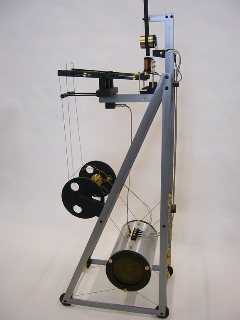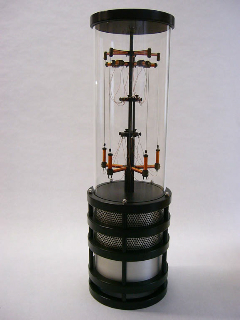Artist Talk and Demonstration
Thursday, January 7, 6 – 8 PM
OLIVER DICICCO ARTIST STATEMENT
My work is about the intersections of disciplines. The point where music, sculpture, mechanics and engineering meet, is an intriguing place for me. I try to create pieces that work on these many levels. My interest in music and sound comes from my many years as an audio engineer and musician. My passion for building and tinkering comes from an early childhood spent in my father’s workshop.
Inspired by the work of Harry Partch, I began building musical instrument sculpture in the late 80’s. That process led to the instruments that would become the Mobius Operandi ensemble. The group progressed from concerts to large inter-disciplinary performances. The performance pieces became the genesis for my work in kinetic sound sculpture. As the scope of the performances grew, the kinetic sculpture became an integral part of the pieces, with dancers, actors and musicians interacting with them.
My latest work explores my fascination with magnetic fields and feedback loops. I find the harmonic resonances and the visual movement of vibrating rods almost hypnotic, the random nature of the sound and the shifting interaction of the resonating frequencies, compelling. I’m drawn to the aesthetic of old analog and tube equipment, and have tried to capture the flavor of that era in the visual elements of the pieces.
PENTODE, utilizes shifting magnetic fields to create a feedback loop in the lengths of guitar strings suspended above electromagnets. The strings are positioned near electromagnetic pickups, the sound from the pickups is routed to an amplifier, the output of which feeds a speaker as well as the electromagnets. At the end of each string is a magnet which is repelled or attracted by the changing field in the electromagnets, causing the strings to resonate in a feedback mode.
OTYPE field effect, works on a similar principal to PENTODE. The piece is interactive, turning the large knob on the top of the base, will change the gain of the feedback, affecting the vibration of the rods, and the spinning of the rubber rings.
WAITING FOR THE BIG ONE uses electromagnets which are turned on an off sequentially by means of an optical switch. As the magnets are energized they attract and repel a magnet located in the base of the pendulum, this causes the pendulum to swing and gain momentum. The rocker arms below the magnets are repelled each time the magnet is on, which in turn causes vibrations in the metal rods at the end of the arms. The vibrations are amplified and fed to a pair of speakers. As the rods touch the rotating strings located below them, upper harmonics are created. The piece reminds me of a seismograph, hence the name.

